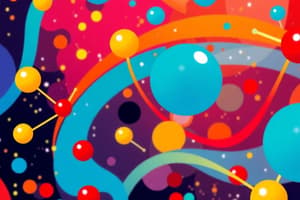Podcast
Questions and Answers
What is the maximum number of electrons that the third shell of an atom can hold?
What is the maximum number of electrons that the third shell of an atom can hold?
- 14
- 10
- 6
- 18 (correct)
Which component of an atom determines its elemental identity?
Which component of an atom determines its elemental identity?
- Nucleus
- Protons (correct)
- Neutrons
- Electrons
How do isotopes of an element differ from each other?
How do isotopes of an element differ from each other?
- They have different numbers of electrons
- They have different atomic mass (correct)
- They have different chemical properties
- They have different numbers of protons
What is the charge of neutrons?
What is the charge of neutrons?
What is the most tightly bound shell to the nucleus in an atom's atomic structure?
What is the most tightly bound shell to the nucleus in an atom's atomic structure?
What is the atomic mass of carbon-13?
What is the atomic mass of carbon-13?
What is the main factor determining the strength of covalent bonds?
What is the main factor determining the strength of covalent bonds?
Which type of bond is typically stronger, ionic or covalent?
Which type of bond is typically stronger, ionic or covalent?
What kind of atoms form hydrogen bonds?
What kind of atoms form hydrogen bonds?
What do molecules depend on for their structure and properties?
What do molecules depend on for their structure and properties?
Flashcards are hidden until you start studying
Study Notes
Chemistry is the scientific discipline that deals with the composition, structure, properties, and behavior of matter. Atoms and molecules are the fundamental building blocks of all matter, and understanding their properties and interactions is crucial to understanding the world around us.
Atoms
Atoms are the basic unit of matter, and they consist of three main components: protons, neutrons, and electrons. Protons are positively charged particles, neutrons are neutral particles, and electrons are negatively charged particles. The number of protons in an atom determines its elemental identity, while the number of neutrons and electrons can vary, leading to different isotopes and compounds.
Atomic Structure
The atomic structure of an element is determined by the arrangement of its electrons. Electrons occupy energy levels or shells, and each shell can hold a maximum of 18 electrons. The first shell can hold a maximum of 2 electrons, the second shell can hold a maximum of 8 electrons, and so on. The electrons in the first shell are the most tightly bound to the nucleus, while the electrons in higher energy levels are more loosely bound.
Isotopes
Isotopes are atoms of the same element that have the same number of protons but different numbers of neutrons. This leads to the same number of electrons and similar chemical properties, but different physical properties like atomic mass. For example, carbon has two stable isotopes: carbon-12, which has 6 neutrons, and carbon-13, which has 7 neutrons.
Atomic Mass
Atomic mass is a measure of the mass of an atom. It is calculated as the sum of the proton mass and the neutron mass, and it is typically expressed in atomic mass units (amu). The atomic mass of an element is an average value due to the presence of isotopes.
Molecules
Molecules are groups of two or more atoms bonded together. Molecules can be simple, like oxygen (O2) or water (H2O), or complex, like proteins or DNA. The structure and properties of molecules depend on the type and arrangement of their atoms.
Covalent Bonds
Covalent bonds are the main type of chemical bond that forms between atoms in a molecule. In covalent bonds, atoms share electrons to achieve a stable electron configuration. The strength of covalent bonds depends on factors like the electronegativity difference between the bonded atoms.
Ionic Bonds
Ionic bonds occur when an atom transfers one or more electrons to another atom, creating an ion and a charged particle. These charged particles are attracted to each other, forming an ionic bond. Ionic bonds are typically stronger than covalent bonds.
Hydrogen Bonds
Hydrogen bonds are weak, non-covalent interactions that occur between a hydrogen atom bonded to a highly electronegative atom (like oxygen or nitrogen) and another highly electronegative atom. Hydrogen bonds play a crucial role in the structure and stability of biological molecules like DNA and proteins.
Conclusion
Understanding the properties and interactions of atoms and molecules is essential for understanding the world around us. By studying the structure, bonding, and behavior of these fundamental building blocks, we can gain insights into the composition, properties, and reactions of matter. This knowledge is crucial for developing new technologies, improving our understanding of biological systems, and solving some of the world's most pressing challenges.
Studying That Suits You
Use AI to generate personalized quizzes and flashcards to suit your learning preferences.




